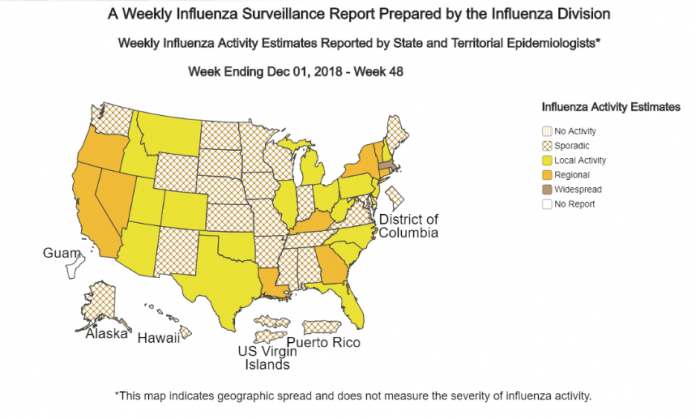
PROVIDENCE — Flu activity is about level with this time last year in Rhode Island, accounting for 0.59 percent of physician office visits, but if last year is any guide, a steep spike could begin next month with neighboring states already seeing higher rates.
Last year at about this time, Rhode Island had attributed about 0.54 percent of physician office visits to influenza, according to R.I. Department of Health data. The data point was just prior to a rise in the frequency of flu cases that peaked at 7.82 percent of physician visits last year.
Joseph Wendelken, spokesman for the R.I. Department of Health, noted that in neighboring Massachusetts, flu cases have been designated as widespread, or reported in more than half of the state’s regions, by the Centers for Disease Control and Prevention. Toward the south and west, Connecticut flu cases are designated less severe, at a regional spread with outbreaks in more than two but less than half of the regions in the state, according to the CDC. Flu is still more widespread there than Rhode Island’s current “sporadic” flu spread designation, with small numbers of lab-confirmed flu.
“Anyone who has not been vaccinated yet should get vaccinated as soon as possible. This is especially important for the elderly, pregnant women, young children, and people with underlying medical conditions (for example, asthma, diabetes, etc.),” Wendelken said.
According to the CDC, It takes about two weeks after vaccination for antibodies that protect against flu to develop in the body, so ideally, people should get vaccinated early in fall, before flu season begins, by the end of October. Getting vaccinated later, however, can still help, and vaccination should continue to be offered throughout flu season, even into January or later, according to the CDC.
This year’s quadrivalent (protecting against four virus strains) flu vaccine protects against the following strains of the virus:
- A/Michigan/45/2015 (H1N1)pdm09-like virus
- A/Singapore/INFIMH-16-0019/2016 A(H3N2)-like virus (updated)
- B/Colorado/06/2017-like (Victoria lineage) virus (updated)
- B/Phuket/3073/2013-like (Yamagata lineage) virus
Trivalent (three-component) vaccines, only protect against the first three strains, according to the CDC.
All flu vaccines (for children and adults) this year are quadrivalent, except for Fluzone High Dose, which is for people ages 65 and older. If someone 65 or older wants a flu shot, they can request the quadrivalent vaccine or Fluzone High Dose. It is up to the patient in such a case, Wendelken said.
Rob Borkowski is a PBN staff writer. Email him at Borkowski@PBN.com.












